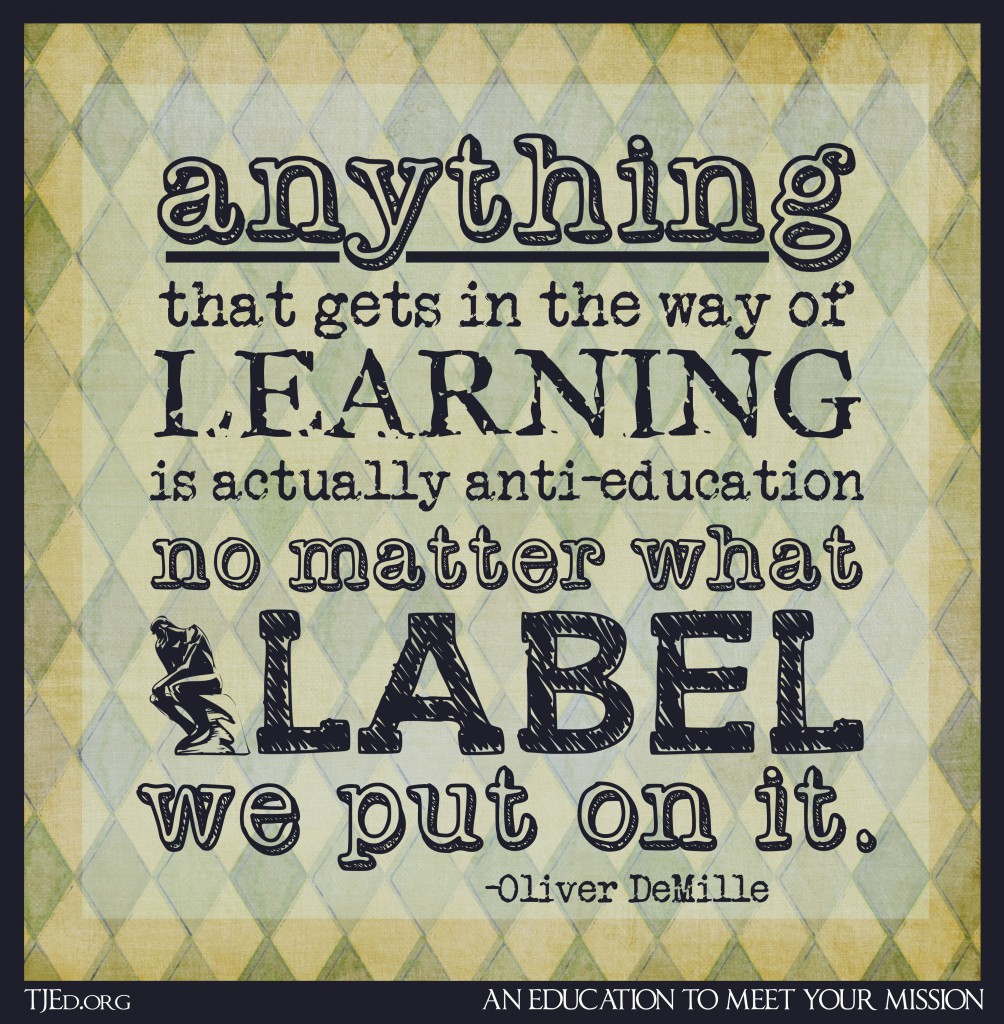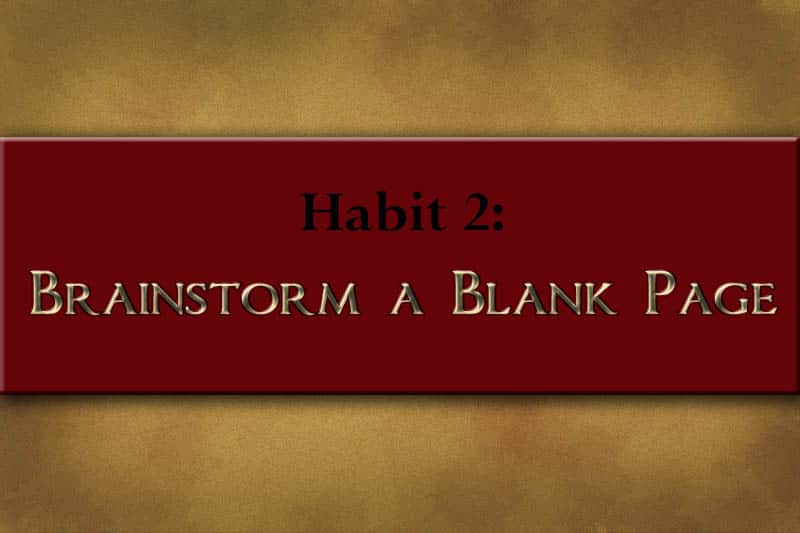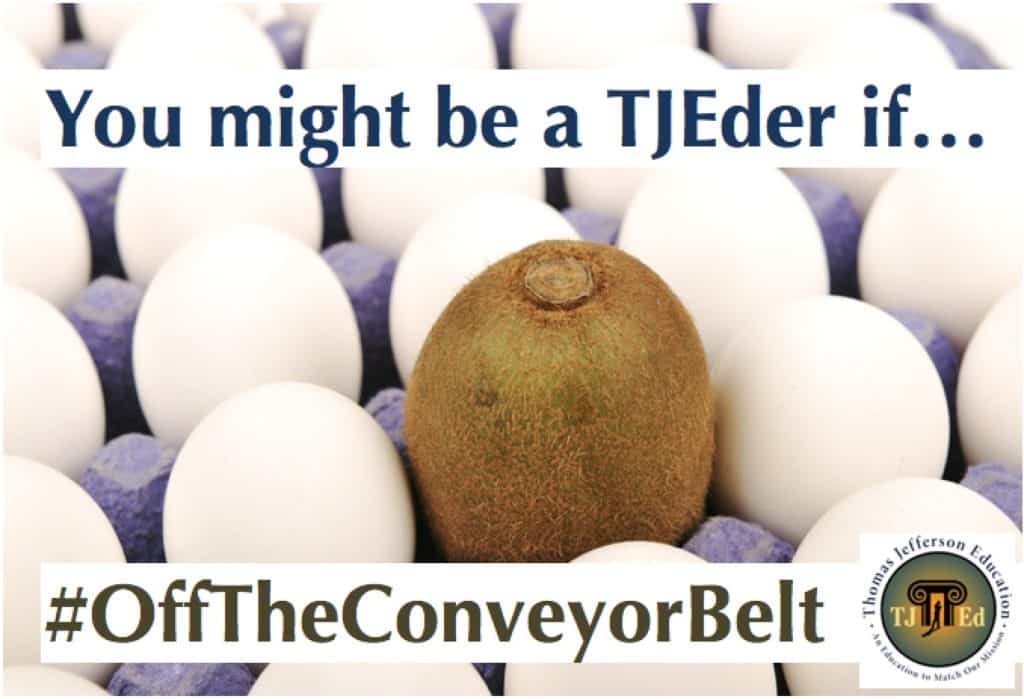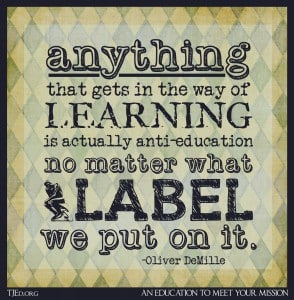Homeschool and Testing, Part I
by Oliver DeMille
Lessons and Differences
 I was halfway through my meal in a crowded Los Angeles restaurant when it happened. I glanced up and noticed a man staring at me from the next table. I wondered what he was staring at, so I smiled. He grinned back, then began scrutinizing his napkin. Yes…his napkin.
I was halfway through my meal in a crowded Los Angeles restaurant when it happened. I glanced up and noticed a man staring at me from the next table. I wondered what he was staring at, so I smiled. He grinned back, then began scrutinizing his napkin. Yes…his napkin.
I was so surprised that I watched him for a minute, and I soon realized what was going on. His napkin was spread out on the table like a large place mat. In fact, his whole family had their napkins arranged as place mats, with their plates, cups, and utensils all on top of the napkins. Together their napkins covered the whole table in a makeshift tablecloth.
The man had seen me using my napkin on the corner of my mouth—and it had shocked him. I imagine him thinking: “What kind of people use their place mats on their mouth?”
By this point he was explaining the situation to his family members, all of whom were pointing around the room at other people using their napkins as…well, napkins. Not place mats. They were speaking in a foreign language I don’t understand, so I couldn’t tell what they were saying about their new discovery.
Soon they began laughing, and somewhat sheepishly they lifted their cups and plates, moved the napkins from their position laid out on the table, and put them in their laps like napkins. It was clear that they considered this a very strange custom. When Rachel returned to the table, I related to her the goings-on, and she chuckled, “Well, either one or both of you is really weird – depending on who’s doing the evaluation.”
My thoughts returned to her comment later that day, when she asked me what I would say to people who wonder why elementary and high school age homeschoolers who take standardized exams often test way above average in some areas but well below them in others. I thought it was a poignant question, and it brought to mind a friendly conversation I once had with a school principal.
Who Lands Where
We served on a charitable committee together, and one day in a moment of waiting he mentioned that homeschoolers in his district who for whatever reason take the district’s standardized tests nearly all test “off the charts” high in Language Arts and Social Studies, but well under the curve in Science and Math.
Then he cocked his head to one side and said, “Except for two homeschooling families in the district whose kids test the exact opposite—very high in Math and Science, and quite low in Language Arts and Social Studies.” He wondered why this trend was so prominent. Why didn’t they all test to the averages, like most of the schools?
I had just about the same reaction to him that I did to the man in the restaurant with his family’s napkins under their plates. How do you tell somebody from one culture what a very different culture is like? Certainly not easily, simply, or quickly. There’s more to it than that.
Still, I tried. First I referred him to national statistics that show the average of public school students (tested across the board on academic topics) in the 50th percentile, private school students in the eighties, and homeschoolers in the nineties.
As I remember it, he shook his head and said: “I’ve researched all those statistics, and they don’t hold up because the public school numbers represent all students in public school while not all homeschoolers decide to take such tests. If we made the same tests voluntary in public schools, we’d get much higher results too—because most of those who would take them would be well prepared.”
That made sense to me, so I tried another response. “Good point. The truth is that many homeschoolers don’t really respect multiple choice testing. It’s not the best way to know what students have really learned. Essay exams are much better. And oral exams are even more effective. You can really explore a student’s learning with oral exams.”
The High and The Low
He nodded his head vigorously. “I agree. But that isn’t an option for most public schools. We are required by law to use standardized tests, most of which are multiple choice. Parents, teachers, and administrators have little say about that. And we spend a lot our time teaching to the mandated tests.”
I asked, “Do you think you could greatly improve testing and learning if you and your teachers could design the tests yourselves instead of having to teach to those mandated?”
“Absolutely!” he suddenly got passionate about the topic.
I replied: “Well, that’s exactly what many homeschooling parents are doing. They are designing the kind of assessment they think best measures what they want to emphasize in their kids’ education. That’s why some families excel in Math and others in Language Arts, because they have different values, goals, and objectives.”
He pondered, then nodded. “That makes sense. But what about the students who don’t do well in certain important subjects, like Math? What do homeschoolers do about this?”
“Well, what do public schools do with students who don’t do well in Math, Science, or some other topic?” I asked. “Or do all public school students excel in every subject?”
He grinned good-naturedly. “Touché,” he said. Then his face turned serious. “But at least we try. When a student is behind in a field of study, we work hard to help the student catch up. Do homeschoolers do this?”
I laughed. Still chuckling, I replied, “No, not at all. Homeschoolers tell their kids to avoid subjects like Math and English and never try to learn such topics under any circumstances…” I struggled for the right way to finish my joke.
Goals
He chuckled before I could complete my thought. “Of course they try. I didn’t mean to offend. It’s just that my main experience with homeschoolers comes when a family stops homeschooling and their kids enter public school—and their assessment tests show them low in some area.”
I nodded. “That would be frustrating. But like you said earlier, they are usually very high in some other topics, right?”
“Yes, nearly always.”
 I responded: “But homeschoolers aren’t the only ones like that, right? I mean, do you have students who have been in public school their whole life, who test high in one or two topics and low in others?”
I responded: “But homeschoolers aren’t the only ones like that, right? I mean, do you have students who have been in public school their whole life, who test high in one or two topics and low in others?”
He smiled and sighed. “I see your point. Of course many students test high in some subjects and low in others.”
“I bet certain students test high in most or even all subjects, and some test low in all topics. And many test in the middle on everything. Right?”
“Yes, of course,” he replied.
“So, really, it’s exciting when any student tests high in anything, right? So you should be really happy with any homeschooler or public schooler, or private schooler, who comes into your school testing high in anything. Right?”
He laughed. “Conservatively optimistic, yes,” he said. “But we would like them all to test high in everything.”
“So would pretty much all homeschooling parents, I think,” I said. “But a lot of homeschoolers are more interested in their students truly excelling and learning ‘off the charts’ in some important topics, so they may spend more time on those areas of focus. That would explain the high scores in subjects they care about a lot.”
Meeting It
We both nodded. Then I chuckled again, and said, “Maybe the homeschoolers who test low in Math and Science should take classes at public school and the public school students who test low in Language Arts and Social Studies should attend some of the local homeschools.”
He grinned widely. “I’d have a hard time selling that one.”
“So would I,” I replied.
We both laughed.
It was an interesting conversation. I felt like I really understood his views on the topic much better than before, and I think he understood mine as well. In fact, it was a lot like the man’s napkin at the restaurant in L.A.
The truth is, those nice cloth napkins really did make good place mats. How sad it would have been if I’d started criticizing using the “napkin” that way and the man had started lecturing me on using my “place mat” wrongly. I’m glad we both smiled and understood each other instead—even with the cultural divide.
We each had different goals with those napkins, but they both worked. We both met our goals.
And that’s the real issue, after all. If a public school meets a given family’s goals for a certain child, excellent! Who is anybody else to tell those parents they should make changes? Or if a homeschool plan meets your goals for a child, why should anyone else have the right to change your way of doing things? They shouldn’t.
And this brings us to the deeper problem.
Napkins or Place Mats?
The real challenge: Do you know your family’s educational goals for each child? If not, that’s a real problem.
That’s where the “Brainstorm a Blank Page” habit comes in, as discussed in our book The 5 Habits of Successful Homeschoolers. We call it “Blank Page Mentoring” in this post.
This really matters. If you know the right individual goals and objectives for your children and youth this week, and every week, you’ll know how to make excellent decisions regarding their education. If not, you won’t. Knowledge really is power.
And let’s be clear: Testing is secondary, or more accurately, tertiary, to learning. Learning is the real goal of quality education. And different kinds of learning naturally resonate with different kinds of testing. But the starting point isn’t testing. Not at all. It’s knowing what the right objectives are right now for each child’s education.
Knowing these objectives—really knowing them—will tell you how he or she should learn and how his or her learning can be most effectively tested or assessed. This is the key place to start the education of every child, and it is the sole responsibility of each child’s parents. Period.
 Some parents delegate this duty or just leave it to someone else. But we should all celebrate parents who don’t delegate this profound role in society. We need many more such parents.
Some parents delegate this duty or just leave it to someone else. But we should all celebrate parents who don’t delegate this profound role in society. We need many more such parents.
In fact, here’s a powerful standardized test we might offer all parents in our modern world:
“How well do you carry out the great responsibility to always know the right individualized educational goals and objectives for each of your children—each week, every week? And, knowing them, how well do you implement them? Or, to what extent do you delegate—or simply leave—this vital parental duty to others?”
How do you score? How can you improve? Will you start today, right now?
What a great exam.
So, finally, which is best: Napkins or place mats? It all depends on your goals. The key is to make sure that as a parent you really know and embrace the right goals for each child—every week. Nobody can do this as well a loving, dedicated, focused parent.
Once you know this, and live it, selecting the right kind of testing will come naturally and easily.


































Love the post. Just two additional insights.
First, families should determine whether it’s important for Johnny to get into a competitive college. Nearly all homeschool students who are college bound will have to sit for the ACT or SAT at some point in the future, and both exams have a math section. A student could test perfectly on the reading and English sections of the ACT, and flop the math and science sections, for an average score of 20-23. Students who follow the path described in this article are likely do something like that, based on my experience, and will then be admitted to non-competitive colleges. For many families who have worked very hard for decades to ensure that their students are exposed only to the highest quality resources while homeschooling, the fact that these students are now limited to mediocre colleges represents an ironic and under-thought change of mojo. Additionally, our experience is that homeschool students have what it takes to do fabulously well on the ACT and SAT and receive scholarships, if they can jump the math and science hurdle. Whether we want to admit it to ourselves or not, students who want to be admitted to highly competitive schools will be prevented from doing so unless they bring up their math and science scores, which means doing math and science on a daily basis, regardless of whether Mom and Dad like math, and regardless of whether Johnny is naturally gifted at math. Probably it means getting some outside mentoring in the subjects on which Johnny struggles most.
That said, college is not what it used to be in our economy, and the cost of college degrees is rising at roughly the same rate at which the value of those degrees is dropping in the market. Thank you to Google, Apple, and other tech companies who place a premium on actual skills rather than etherial knowledge or certification structures like colleges that are far removed from the skills actually needed in the workplace. Still, as a general trend, those with college degrees make more money and have more options than those who don’t, so this is a super important decision to make, and one that should be made early on so families can strategize about subjects like math and science early on.
Second, and related, homeschool parents should be very honest with themselves about the extent to which they are choosing to emphasize certain subjects and de-emphasize others based on their own subject matter expertise. Students will often surprise their parents by responding well to subjects in which parents have little interest, when students are exposed to excellent outside mentors who are passionate about these subjects. This is especially important when kids turn about 11 or 12. In other words, it’s easy for a homeschool family to become an echo chamber and fail to get outside exposure that would be very beneficial for students. That’s why our team coined the word “homesourcing” to replace the word “homeschooling.” The savviest families are no longer asking, “How can I be a one-room school house for my family?”; they’re asking, “how can I, as the educational CEO of my family, direct the highest quality learning experiences to each of my children, regardless of whether I provide them or I bring others onto my family’s team to provide them?” With today’s ever-increasing abundance of educational opportunities, students whose parents take the homesourcing approach have more exposure to better resources and mentoring, and can still inherit the strengths Mom and Dad have to offer, without being stuck with Mom’s and Dad’s weaknesses. For more info on homesourcing, see this article: http://www.williamsburgacademy.org/from-parent-pioneer-to-parent-ceo/
Perhaps I’ve just provided you fodder for part two of this topic.
It is interesting that even though I love math and have always excelled at it personally, my children are mediocre in it. As young children we would play family games with math and See how many goldfish were left after the shark ate some. They did very well then. In the middle years though when math becomes something more individual and you ask mom’s help if you need it they lost interest. Not until highschool when they realized they were behind did they go back to it so that they could get into a competitive college. By this time the fun is not there and while they do just fine I am left feeling that I missed something as a parent. I am working on figuring out how to have math, like science, reading aloud history and literature etc be something inspiring again for my kids that are still in the middle years. Something that we can do as a family. I have in the past been working on doing math questions when they do theirs, perhaps going back to that is in order. This is important.
Excellent article Oliver. I also agree with James’ comments, very good points, all things we have grappled over as our children grow. Homeschooling has provided an excellent foundation,study habits and healthy attitudes toward learning (love of learning) and has fueled their natural curiosity. However now that they are older, my role has really become more of a “home-sourcer”, and the experience has been amazing!
Knowing that my children needed some extra time spent in the math area, we chose to enroll them in a local montessori school for a while. Our children, like so many of their homeschooling peers, scored at least 3 grades above average on LA comprehension skills etc especially the older ones, the youngest is more of a mixed bag. Seeing them take the reigns and really develop the math skills needed without any preconceived ideas about their own performance is awesome. Allowing others to mentor my children in this area has opened up a whole new world to them and has
helped me see what truly works in our home. The school they are attending only goes to 8th grade, and after that we will seek the mentors needed to help them achieve their goals. Freedom in learning is a truly beautiful thing!
Good article. I do not agree with the above comment too much. First, what is wrong with a “mediocre” college, you still have the same degree in the end. The school behind the degree MAY help in some instances, but only some instances…especially in current times. It more depends on the field of study. Also, the statement made that college graduates make a lot more money…..not if they are living in mom and dads basement defaulting on student loans they aren’t. There are “jobs” that make a living, as much, or maybe more than those with college degrees….again depending on field of study. Electricians, welders, mechanics, plumbers, etc…make a living, and many many many college grads I know of simply make a living too.
James, I love your comment. To summarize your main points: 1) Good math skills are necessary to get into top colleges. 2) The value of college degrees is dropping at “roughly the same rate” that their cost is rising. 3) Still, people with college degrees make more on average than those without. 4) The best homeschool parents apply the concept of homesourcing (meaning that the focus is on helping the student get the best education they can, not just focus on what they can do *at home*.
I would add the following thoughts:
A. Point #2 above deals with people who are currently age 30 and under, while Point #3 relates mainly to those over 30. This is an important point. While it is human nature to base children’s career plans for 10-30 years from now on what we’ve witnessed in the past 30 years, it can well be argued that outcomes for the current 30+ population are not necessarily indicative of what the 30-and-unders will experience – in fact, there is much evidence to suggest that the two have little in common with respect to college and career outcomes. Likewise, the value of mid-range colleges is drastically increasingly relative to the value of top-tier schools – while the value of both is rapidly declining, in absolute terms. The relative value of community college is rising even more than these others. Note that this does not mean the *education* is losing value (quality education is, in fact, increasing in value), but that the degrees themselves are losing value. As you so eloquently noted, the trend now is leaning toward skill over degree. In fact, there is very little research or literature suggesting that today’s under-20 crowd will be able to shop degrees with any solid expectation. See, for example, William Bennett, Is College Worth It? (2013); William Deresiewicz, Excellent Sheep (2014); Andrew Delbanco, College: What It Was, Is, and Should Be (2013); Jeffrey Selingo, College Unbound: The Future of Higher Education and What It Means for Students (2013); Glenn Reynolds, The New School (2014); Kevin Carey, The End of College: Creating the Future of Learning and the University of Everywhere (2015); Glenn Reynolds, The Higher Education Bubble (2012); Ryan Craig, College Disrupted (2015). There are about two dozen others. Note that there are exactly -0- such books that I can find arguing that the current college/university structure will continue to operate as it does now, or that hiring and careers will be based on the current college training model. The closest to this is Bennett’s book listed above. But even he admits that he is old-school, and really just *hopes* it stays this way.
B: None of this in any way suggests that math and science aren’t a vital part of any person’s education. The truth is that they are. What this is showing, and in fact, what I was trying to get at (and will address further in Part II of this article) is that teaching to the test has become a major problem in math and science. Actually, in other subjects as well. By teaching to the test in the extreme manner that most mainstream schools do nowadays, we are actually 1) teaching a number of students who can work the math problems and score well on the tests, but don’t really understand the mathematical and scientific principles, and 2) reinforcing – even more strongly than ever before – Gatto’s 7 Lessons, such as rote thinking, class stratification, blind obedience to institutional and government authority and intellectual dependence. These are very real. They represent the literal decline of our republic and our freedoms, if allowed to continue, and I do not believe this is an overstatement. That said: families are put in a dilemma of sorts. On the one hand, they want their students to test well, get into good colleges and hopefully turn college degrees into lucrative careers. And on the other hand, the system that follows this path, while considered mainstream, is the very model (the Prussian model, to be precise) that will create a larger class divide, and fuel increased rule by elites. In the immortal words of Bill Murray: “That sucks!”
Thanks so much, James, for a well-thought-out, pragmatic, savvy view of what’s going on, and the choices available. From my admittedly idealistic perspective, I’m convinced that we need much better math learning and that this simply will not occur by teaching to the test. And, I am convinced, from everything I’ve researched, that the current college model is a dinosaur and today’s young people in elementary school will need a great *education* and no credential except in a few specific fields such as medicine and law. I’m also convinced that law and medicine will dump college credentials and come up with their own licensing models. They are already experimenting in this direction. I say that this is an idealistic view, but in fact, 20 years from now, I’m absolutely convinced that we’ll all be living in this very reality. That makes it realism and pragmatism, if it goes that way.
One thing is certain: It won’t be what it is today.
Thanks for this dialogue, Oliver. I think it touches on a couple of issues that are central to the concerns of parents who educate at home right now.
I completely agree that standardized testing, and teaching to the test, is an assault on education and a huge problem in America. It’s one symptom of a bigger problem, which is the lack of trust in our education system and people. Besides testing skills that are far removed from life or job skills, and besides how annoying and expensive these tests are to administer, and besides how much they handcuff teachers (and even more problematic, they repel talented teachers from the industry), they can also be incredibly harmful to student learning, which is the biggest problem of them all. They are top-down, hierarchical, outdated, and expensive. Which I guess also summarizes public education right now. So, yeah, I’m with you on that. My point is simply that it’s wise to take a balanced approach and make strategic decisions about standardized testing instead of just standing against it from a theoretical standpoint. An important driving question should be, “What will provide my student the most opportunities in the future?” Which brings us to the question of college.
Regarding college, my research also tells me that college is not likely to perform the same role in the lives of this generation of students that it has in past generations. I also believe that students/families should take a hard look at all the free and paid college alternatives, including internships, gap years, free online courses, certifications in tech skills, and starting one’s own business. College is no longer for every student, and the only source I hear still sending the message it is for every student is public education, which, categorically speaking, tends to be a generation or two behind the times in America. I appreciate the list of resources, and plan to dig deeper into this subject.
On the flip side, it’s one thing to acknowledge that the role of college is shifting and changing, and will be very different in 20 years, and another to jump off the ship today, right now, in this generation. Although college is becoming less likely to actually prepare students for their careers, it still serves several important functions for which no other single alternative exists for young people in this generation, including:
1 – Social & Professional Connections. If you go to Standford, BYU, or any other highly selective school, you will find yourself in the midst of some of America’s brightest, most ambitious youth. Just talk to students who take tech jobs or start their own businesses right out of college about their social life, and you’ll hear many of them express a certain pain and loneliness, and yearning for the social opportunities provided by college. When searching for a spouse, future business colleagues, or lifelong friends, college’s social scene is deeply embedded in our culture and I don’t see any replacement in the immediate future. Sure, other entities will emerge to compete over the next 20 years, but they don’t yet exist so this is a risk students take who do not attend college.
2 – Liberal Education. Unless you’re lucky enough to acquire a deep and broad liberal education in high school, which is a rare exception, college provides the only exposure to literature, history, psychology, advanced math and science, and discussions around these topics that many students are likely to experience in their lives. Yes, class sizes and poorly selected texts are an issue, but many freshman courses still include fantastic literature and great class discussions with professors who are steeped in the liberal arts. That’s a good thing––or at least better than nothing, which is what most of these same students are likely to get if they opt out of college. Some students will also attend true liberal arts colleges where classic literature and great discussion are certainties. Again, I believe other entities will rise up and make the case for liberal education from a non-institutional perspective (see http://www.nytimes.com/2007/07/21/business/21libraries.html?_r=0) but right now there are very few support structures designed to help students achieve a liberal education outside of a college atmosphere. There might be 20 years from now, but that doesn’t help the class of 2015. Or 2016. Or 2017.
3 – Preparation for Professional Work. You mentioned medicine and law, but when you start thinking about the number of jobs that still require college degrees, it’s staggering. Medical (nurse, PA, doctor, psychologist, therapist, counselor, etc.), accountant, attorney, teacher (everything from primary to secondary to higher ed), many government and military positions, etc., not to mention the number of jobs that still list a college degree as preferable. So it’s not just doctors and lawyers, it’s a whole slew of the jobs for which many students will be competing in the next 20 years, that will be closed to those without college degrees.
I’m looking forward to Part II. Thanks again for the dialogue.
I actually find that teaching science to my kids is easier than history or literature. It helps that I have 4 boys. They are naturally inquisitive about the world around them and how things work. That is science. They naturally are passionate about animals, gardening, nature, geology, astronomy, and physics (how things work). They love to create forts, build pine wood derby cars, bake cookies, learn about the body, look through telescopes and microscopes, and study lizards, snakes, insects, birds, mammals, and parasites. The cool thing is that I only need to provide them access to good books and websites and a few inexpensive science tools and they teach themselves and they teach me about these things. How often do we use the scientific method in the observations we make about the world around us?
My boys love The King of Random YouTube channel where he gives great tutorials on how to build all kinds of science and engineering things.
Well, it probably helps that my husband has always been fascinated with science. He is an orthodontist and has taken scores of biological and medical science classes. His dad has a passion for chemistry and passed that on.
But my point is that I am not a scientist and I am the main one mentoring my kids. I have a love of learning interest in science so I have encouraged my kids to pursue their love of science and I have learned so much in the process.
So my point is that we just need to follow up with our kids’ natural scientific curiosities with great non fiction library books, trips to science museums, observatories, zoos, and hikes in nature or just letting them play in the dirt in the back yard. Then once the kids get to high school physics, biology, chemistry, they will easily catch on because they have already played with it all before.